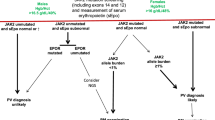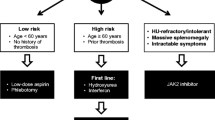Abstract
Hydroxyurea (HU) is effective in controlling thrombocytosis while reducing the risk of thrombosis in essential thrombocythemia (ET), polycythemia vera (PV) and myelofibrosis (MF). However, HU may carry more or less severe side-effects. Rare cases of patients with painful leg ulcers have been published. We report our experience on such a side-effect in a large cohort of patients with ET and PV treated with HU and review the literature on the topic. Five (4%) out of our 124 patients (69 ET, 51 PV, 4 MF; 49 males, 75 females; mean age at diagnosis 59.1±11.8 years) treated with HU developed painful leg ulcers. Sixty-one other patients affected with Ph− myeloproliferative disorders (Ph− MPD) developing HU-related painful leg ulcers are described in the English literature. All our five patients were women and developed leg ulcers over the age of 75. Sixty-five percent of all described cases are women; 59% were over 65 years of age and 45% over 70. Most cases received over 1 gr HU per day for at least 1 year. The pathogenesis of HU-induced skin ulcers remains elusive. Treatment is difficult and requires prompt cessation of HU therapy.
Similar content being viewed by others
References
Yarbro JW. Mechanism of action of hydroxyurea. Semin Oncol 1992; 19 (Suppl 9): 1–10.
Murphy S. Therapeutic dilemmas: balancing the risk of bleeding, thrombosis and leukemic transformation in myeloproliferative disorders (MPD). Thromb Haemost 1997; 78: 622–6.
Cortelazzo S, Finazzi G, Ruggeri M, et al. Hydroxyurea for patients with essential thrombocythemia and a high risk of thrombosis. N Engl J Med 1995; 332: 1132–6.
Randi ML, Ruzzon E, Luzzatto G, Tezza F, Girolami A, Fabris F. Safety profile of hydroxyurea in the treatment of patients with Philadelphia-negative chronic myeloproliferative disorders. Haema- tologica 2005; 90: 261–2.
Kennedy BJ, Smith LR, Goltz RW. Skin changes secondary to hydroxyurea therapy. Arch Dermatol 1975; 111: 183–7.
Berlin NI. Diagnosis and classification of the polycythemias. Semin Hematol 1975; 12: 339–51.
Murphy S, Iland H, Rosenthal D, Laszlo J. Essential thrombo- cythemia: an interim report from the Polycythemia Vera Study Group. Semin Hematol 1986; 23: 177–82.
Vassallo C, Passamonti F, Merante S, et al. Muco-cutaneous changes during long-term therapy with hydroxyurea in chronic myeloid leukaemia. Clin Exp Dermatol 2001; 26: 141–8.
Hirri HM, Green PJ. Skin lesion caused by hydroxyurea. Eur J Haematol 2001; 67: 328–9.
Chaine B, Neonato MG, Girot R, Aractingi S. Cutaneous adverse reactions to hydroxyurea in patients with sickle cell disease. Arch Dermatol 2001; 137: 467–70.
Sirieix ME, Debure C, Baudot N, et al. Leg ulcers and hydrox- yurea: forty-one cases. Arch Dermatol 1999; 135: 818–20.
Poros A, Nadasdy K. Leg ulcer in hydroxyurea-treated patients. Haematologia (Budap) 2000; 30: 313–8.
Olesen LH, Pedersen BB. Hydroxyurea-induced leg ulcers in patients with chronic myeloproliferative disorders. Ugeskr Laeger 2001; 163: 6908–11.
Nguyen TV, Margolis DJ. Hydroxyurea and lower leg ulcers. Cutis 1993; 52: 217–9.
Best PJ, Daoud MS, Pittelkow MR, Petitt RM. Hydroxyurea-in- duced leg ulceration in 14 patients. Ann Intern Med 1998; 128: 29–32.
Disla E, D’Eamour L, Cioriou M. Hydroxyurea-associated leg ul- ceration. Ann Intern Med 1998; 129: 252–3.
Weinlich G, Schuler G, Greil R, Kofler H, Fritsch P. Leg ulcers associated with long-term hydroxyurea therapy. J Am Acad Dermatol 1998; 39: 372–4.
Ravandi-Kashani F, Cortes J, Cohen P, et al. Cutaneous ulcers associated with hydroxyurea therapy in myeloproferative disorders. Leuk Lymphoma 1999; 35: 109–18.
Vélez A, García-Aranda JM, Moreno JC. Hydroxyurea-induced leg ulcers: is macroerythrocytosis a pathogenic factor? J Eur Acad Dermatol Venereol 1999; 12: 243–4.
Bader U, Banyai M, Boni R, Burg G, Hafner J. Leg ulcers in patients with myeloproliferative disorders: disease or treatment- related? Dermatology 2000; 200: 45–8.
Yeh H, Lichtman SM. Hydroxyurea-induced cutaneous ulceration in older patients. J Am Geriatr Soc 2000; 48: 232.
Natarajan S, Williamson D, Grey J, Harding KG, Cooper RA. Healing of an MRSA-colonized, hydroxyurea-induced leg ulcer with honey. J Dermatol Treat 2001; 12: 33–6.
Young HS, Kirby B, Steward JC. Aggressive, extensive, vasculitic leg ulceration associated with hydroxyurea therapy and a fatal outcome. Clin Exp Dermatol 2001; 26: 664–7.
Demircay Z, Comert A, Adiguzel C. Leg ulcers and hydrox- yurea: report of three cases with essential thrombocythemia. Int J Dermatol 2002; 41: 872–4.
Sastre JL, Bravo A, Tembrás S, Gomez R, Ulibarrena C. Leg ulcers associated with hydroxyurea therapy. Haematologica 2003; 88 EIM01.
Montefusco E, Alimena G, Gastaldi R, Carlesimo OA, Valesini G, Mandelli F. Unusual dermatologic toxicity of long-term therapy with hydroxyurea in chronic myelogenous leukemia. Tumori 1986; 72: 317–21.
Kido M, Tago O, Fujiwara H, Ito M, Niwano H. Leg ulcer associated with hydroxyurea treatment in a patient with chronic myelogenous leukaemia: successful treatment with prostaglandin E1 and pentoxifylline. Br J Dermatol 1998; 139: 1124–6.
Stagno F, Guglielmo P, Consoli U, Fiumara P, Russo M, Giustolisi R. Successful healing of hydroxyurea-related leg ulcers with topical granulocyte-macrophage colony-stimulating factor. Blood 1999; 94: 1479–80.
Barbui T, Barosi G, Grossi A, et al. Practice guidelines for the therapy of essential thrombocythemia. A statement from the Italian Society of Haematology, the Italian Society of Experimental Haematology and the Italian Group for bone marrow transplantation. Haematologica 2004; 89: 215–32.
Author information
Authors and Affiliations
Corresponding author
Rights and permissions
About this article
Cite this article
Ruzzon, E., Randi, M.L., Tezza, F. et al. Leg ulcers in elderly on hydroxyurea: a single center experience in Ph− myeloproliferative disorders and review of literature. Aging Clin Exp Res 18, 187–190 (2006). https://doi.org/10.1007/BF03324647
Received:
Accepted:
Published:
Issue Date:
DOI: https://doi.org/10.1007/BF03324647




